Peter Georgakopoulos // NEX.exe Beta Devlog
Hi, this is Peter from Team Fusion, here with my third devlog for our psychological horror game, Nex.exe. As our beta has come close to its end, my focus has been on programming features and polishing gameplay to deliver the narrative experience we want. Please enjoy my breakdown:
Say hello to.... NEX | Programming Nex Feature
The infamous A.I. antagonist of our game is finally implemented in a near-final version.
Nex is a new A.I. assistant sent by your employer to empower you in doing your work. What the player will soon realize over the game is that Nex is doing more than you think. He's automating your entire workflow, and eerily causing people to get fired to "rightsize" the team.
Here is a clip of the player using him:
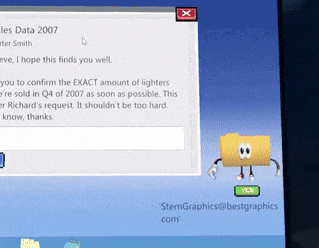
I laid out my intentions for making Nex in my previous devlog where I talked about how Nex will check the current email open and respond based on that. That's exactly what I did.
Nex can detect if an email has an actual response required or if its spam, giving different messages depending on if its relevant or not. Additionally, each time the player uses Nex they need to wait for him to load, which dynamically overwrites a TextMeshPro field below. He currently doesn't have any animations but there are sound effects and feedback for using him. Now when a player asks for help he will give the answer for the current email open, making the process of completing that task extremely fast.
Nex went through a few evolutions. Initially, I had a vision of making him his own tab, and made that implementation:
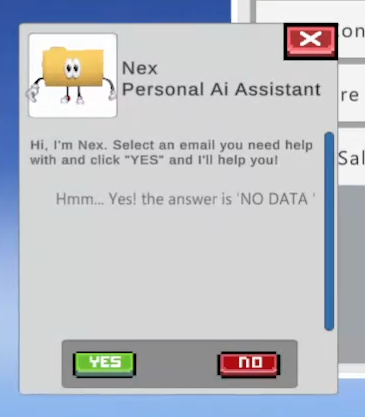
This had a few problems that arose UX-wise. Primarily, we found in our alpha playtest that players weren't even opening him or using him very much due to the fact he was on his own tab and other tabs could cover him.
Additionally, notice the scroll bar on the right of his tab. Each message would appear below, much like a live stream chat. This made it frustrating to tell which response was the newest one and the cropping as more messages came in was difficult to get right.
This led me to scrapping that approach for the current docked Nex section of the screen where he is always on the topmost layer. This means players will always see him and subconsciously process that to potentially give in to his help. But ultimately now, it's a much easier-to-read and use system, and when his animations are implemented I believe it will bring much more life to his character and intentions.
Improving Computer Email Immersion
Before and during the reading week break, one of my tasks was to improve our computer email system for more immersion. Previously, a scriptable object email system would spawn emails in the inbox from the beginning of the game, and each email would have a corresponding document with it. This was a great first step, but to make these emails more dynamic I added a combination of improvements:
- Email inbox filling up over time
As previously mentioned, the game used to start with your email inbox full and the player would never receive any more. To change this, I modified the Email Database script, responsible for storing and distributing the information into the game so that it handled this differently.
How I Did It:
- Analysis: Sending and receiving emails were dull and not very immersive; they were more like a quest board. We found this during check-ins as a team and it was something I personally brought up after.
- Implementation: Modify our scriptable objects and the database script to feed two types of array emails into the email app.
- Outcome: As seen here in the inspector, the email database now has an immediate inbox email array, and a scheduled email array. The immediate inbox emails work as the name entails, much like the original implementation, and the scheduled emails will trickle in over time within a random number between a minimum and maximum delay. Furthermore, a distinct ding sound effect plays each time an email arrives in your inbox, giving players immediate feedback that they received an email.
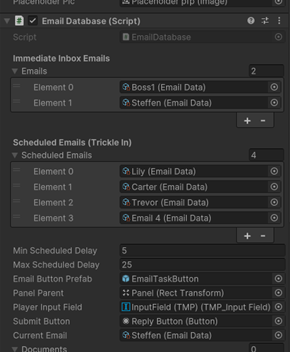
To engage players with the story and the character narratives we want to portray, I added a new follow-up email feature.
How I Did It:
- Analysis: The email app seemed more like a quest board than a live, real place.
- Implementation: Each scriptable object for an email now has some new fields at the bottom, specifically a bool stating whether it has followed-up emails, an array for the follow-up email, and a min/max delay it chooses before sending it. As seen here in the inspector, the email database now has an immediate inbox email array and a scheduled email array. So essentially, each email can be linked to more, creating separate email sending queues simultaneously.
- Outcome: Now, when a player answers an email correctly and it disappears, it will trigger this follow-up email shortly after. The responses from the characters sending the email can make it seem like a real back-and-forth conversation instead of only one-off responses that make the world flat. While we haven’t done official playtesting with this, our internal testing made the characters seem a lot more believable with this system and made it more dynamic. We plan to test the game for its narrative memorability and effectiveness on players during our next playtest.
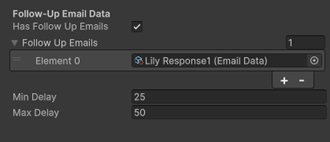
- More personalization for emails
I investigated how we can further improve the UI system in our email app this week. This led to me adding more immersive details. I added a new field in the scriptable objects for profile pictures, and the status for a character (online, idle, do not disturb, offline):

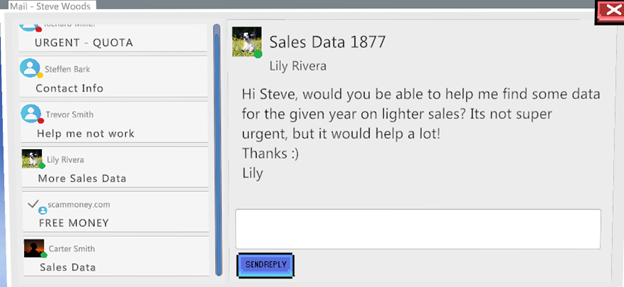
Some key takeaways for designers regarding UI and UX are:
- Take note of big companies who do this professionally like Apple or Microsoft. We have taken inspiration from Outlook and Gmail specifically when designing our interface, and it has helped greatly. I would highly encourage researching to learn from the best. We don’t need to reinvent the wheel, but we need to know why the wheel is great and how we can recreate it ourselves with our flair.
- Sometimes less is more: For us, our game isn’t very action-packed, but that doesn’t mean there wasn’t a lot of work that went into it. Designing for an almost completely UI-based game has been a great challenge, and sometimes I forget the amount of time and effort that has been put into this small room. Sometimes it's good to make one part of the game a focus and polish that instead of trying to do several things and being unable to make that sustainable. For an actual example of this application, my next point involves us removing what was once a significant feature of our game, movement!
Removing Player Movement
In our alpha, we had planned for players to freely be able to move on and off the computer, go to bed to end the days, and potentially interact with parts of the world to progress. What I found through development were huge insights that ultimately led us to scrapping these mechanics. These were:
- Developing the computer was already a huge timesink, and we don’t think we’d have enough time to justify walking around the room and setting up systems there too.
- If the computer is so polished but the movement is poorly executed, the movement could be the biggest takeaway and overshadow all the good things in the game.
So by cutting it loose, we saved ourselves a lot of time that we can reinvest into making the rest of the experience much better. We ended up re-working this into a new menu system that automatically moves you to the computer when you start the game:
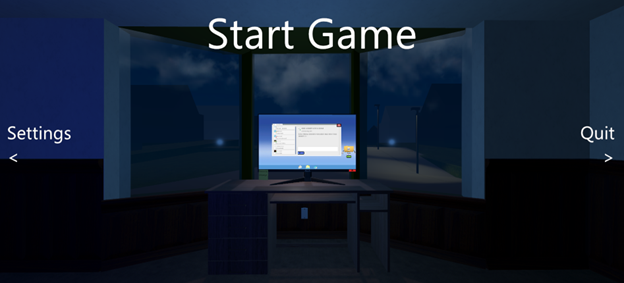
Takeaways and Next Steps:
What was important to me this week was learning how cutting down our scope has led to a better workflow. Instead of trying to add a lot of mechanics and having some fall flat due to time constraints, we chose to polish one for a hopefully better experience.
Learning to remove and say no to things in projects is hard, especially when you've been working with it in mind for a long time. But most of the time it's necessary and healthy in the long run.
The next steps in the project are for me to focus for the next playtest. This means:
- Implementing the text content being developed for the emails. Currently its mostly placeholder characters and images.
- Implementing Nex's animations. Nex now works and responds to emails, but having his animations will sell the character and horror aspect of his character hopefully.
That wraps up my progress for now. I think the game is turning out exceptionally unique and I hope there were some valuable takeaways from my reflection. Thank you for reading and please look forward to the game!
Peter Georgakopoulos
Team Fusion
Get NEX.exe
NEX.exe
Psychological horror game involving an A.I. desktop assistant
| Status | Released |
| Authors | Peter G, Inferno93, MarioCiaralli, Joshua41130 |
| Genre | Puzzle |
| Tags | 3D, artificial-intelligence, First-Person, Horror, Indie, Psychological Horror, Short, Singleplayer, vertical-slice |
More posts
- Joshua Coulter // NEX.exe Beta DevlogMar 21, 2025
- Joshua Coulter // NEX.exe Alpha DevlogFeb 14, 2025
- Peter Georgakopoulos // NEX.exe Alpha DevlogFeb 13, 2025
Leave a comment
Log in with itch.io to leave a comment.